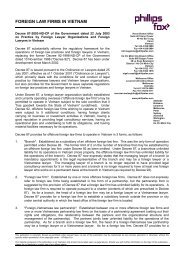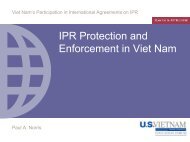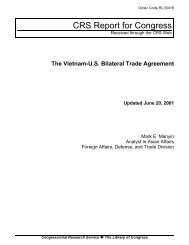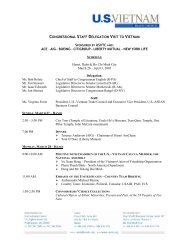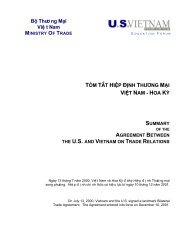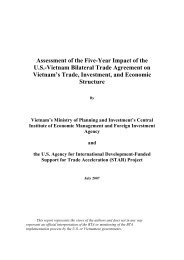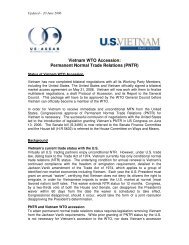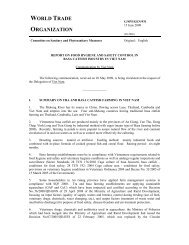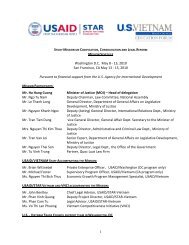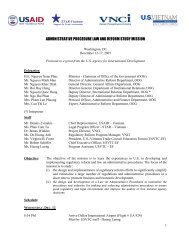Climate risks and adaptation in Asian coastal megacities: A synthesis
Climate risks and adaptation in Asian coastal megacities: A synthesis
Climate risks and adaptation in Asian coastal megacities: A synthesis
- No tags were found...
Create successful ePaper yourself
Turn your PDF publications into a flip-book with our unique Google optimized e-Paper software.
Box 3.3 ■ HCMC <strong>in</strong> 2050Future l<strong>and</strong> use <strong>and</strong> development projections for HCMC were guided by a number of sectoral <strong>and</strong> urban development plans <strong>and</strong> strategies. As perthe adjustment plan, the population of HCMC <strong>in</strong> 2025 is expected to be about 10 million; economic growth <strong>in</strong> HCMC is expected to <strong>in</strong>crease 8 percentannually <strong>in</strong> the period from 2026 to 2050 (ADB 2010). L<strong>and</strong> use for residential purposes is expected to grow by 28 percent <strong>and</strong> for <strong>in</strong>terior traffic by215 percent. The vision underly<strong>in</strong>g the adjustment plan <strong>in</strong>cludes distribut<strong>in</strong>g a population of about 10 million <strong>in</strong> several satellite cities. It assumesgrowth <strong>in</strong> both the <strong>in</strong>dustrial <strong>and</strong> service sectors until 2020. In accordance with this vision, a substantial amount of l<strong>and</strong> <strong>in</strong> HCMC is be<strong>in</strong>g reallocatedfor <strong>in</strong>dustrial purposes. An <strong>in</strong>dustrial master plan prepared by the M<strong>in</strong>istry of Industry estimates this to be around 11,000 ha by 2025. While theadjustment plan recognizes the importance of green space, it also estimates that open areas will decl<strong>in</strong>e by about 25 percent. The adjustment planrefers to climate change but does not address measures needed for <strong>adaptation</strong>.Population projections for 2050 were developed by the study team based on government data <strong>and</strong> Master Plan. This resulted <strong>in</strong> twopopulation estimates, one low estimate of 12 million people, <strong>and</strong> a high estimate of 20.8 million people by 2050. The high population estimateis likely to be more realistic. Future population distributions were also estimated based on current patterns <strong>and</strong> trends <strong>and</strong> are expected to be<strong>in</strong>fluenced by the hollow<strong>in</strong>g out of the city center, higher growth <strong>and</strong> <strong>in</strong>creased population densities <strong>in</strong> peripheral areas, <strong>and</strong> the developmentof satellite cities. In 2006, HCMC had an overall poverty rate of 0.5 percent. While this rate is the lowest <strong>in</strong> the country, the absolute numberof poor <strong>in</strong> the city is still high, at between 30,000 <strong>and</strong> 40,000 people. The HCMC poverty rate was projected to rema<strong>in</strong> significant as climatechange impacts take hold.Rapid economic growth (11.3 percent between 2000 <strong>and</strong> 2007) has been the central driver beh<strong>in</strong>d the city’s expansion, as the <strong>in</strong>creas<strong>in</strong>g number<strong>and</strong> magnitude of <strong>in</strong>come earn<strong>in</strong>g opportunities attract migrants from throughout Vietnam. The HCMC study bases its GRDP numbers on an “AdjustmentPlan” developed by the government. The master plan, which was developed for 2025, conta<strong>in</strong>ed projections to 2050 for GDP. Accord<strong>in</strong>gly, economicgrowth <strong>in</strong> HCMC is expected to be 8.7 percent between 2011 <strong>and</strong> 2025, <strong>and</strong> 8 percent between 2026 <strong>and</strong> 2050. Industrial zones <strong>and</strong> export promotionzones are expected to <strong>in</strong>crease <strong>and</strong> the service sector, <strong>in</strong>clud<strong>in</strong>g f<strong>in</strong>ancial <strong>and</strong> tourism services, is expected to grow rapidly.Source: ADB (2010).Importance of non-climate-related factors<strong>in</strong> contribut<strong>in</strong>g to flood<strong>in</strong>gThe HCMC study shows that a number of nonclimate-relatedfactors also contribute to <strong>and</strong> exacerbatethe impacts of flood<strong>in</strong>g. This <strong>in</strong>cludes domesticsolid waste that is often dumped <strong>in</strong> canals <strong>and</strong> waterways,as well as poor dredg<strong>in</strong>g of canals. Canalsare often choked with water weeds <strong>and</strong> garbage,so that <strong>in</strong> addition to accumulat<strong>in</strong>g sediment, theircapacity to dra<strong>in</strong> storm waters is severely limited(ADB 2010). Further, l<strong>and</strong> subsidence is also animportant problem <strong>in</strong> HCMC, but was not <strong>in</strong>cluded<strong>in</strong> the flood model<strong>in</strong>g simulations because like Manila,l<strong>and</strong> subsidence data were not reliable. Thisis an important limitation of this study. The upperwatershed of the Saigon River <strong>and</strong> Dong Nai River,both of which dra<strong>in</strong> HCMC, are well-regulated withdams <strong>and</strong> reservoirs, <strong>in</strong>clud<strong>in</strong>g the man-made DauTieng Lake <strong>and</strong> Tri An Lake, which are able to reducepeak flood flows associated with extreme precipitationevents. Given the <strong>in</strong>tense management of theHCMC upper watershed, upstream ra<strong>in</strong>fall is notconsidered to be a major factor affect<strong>in</strong>g flood<strong>in</strong>g<strong>in</strong> HCMC. 39 However, the watershed of the DongNai River bas<strong>in</strong> has been subject to considerabledeforestation. Deforestation leads to <strong>in</strong>creased runoff,erosion, <strong>and</strong> sediment release <strong>and</strong> exacerbatesflood<strong>in</strong>g <strong>in</strong> HCMC; this needs to be addressed.Urban plann<strong>in</strong>g <strong>and</strong> assumptions about thecity <strong>in</strong> the futureAs with the other studies, analysis carried out forHCMC built its underst<strong>and</strong><strong>in</strong>g of the future cityon the basis of a vast amount of data relat<strong>in</strong>g tocurrent conditions <strong>and</strong> a number of sectoral <strong>and</strong>urban development plans <strong>and</strong> strategies developedby the government about the future (Box 3.3).Briefly, the plann<strong>in</strong>g system <strong>in</strong> HCMC is shapedby several strategic plans, <strong>in</strong>clud<strong>in</strong>g the urban39The Dong Nai <strong>and</strong> Saigon rivers are heavily regulated byhydropower <strong>and</strong> irrigation dams. They are the ma<strong>in</strong> sourceof energy <strong>and</strong> water supply for HCMC. However, climatechange has not been factored <strong>in</strong>to their construction or operation.Estimat<strong>in</strong>g Flood Impacts <strong>and</strong> Vulnerabilities <strong>in</strong> Coastal Cities | 41



